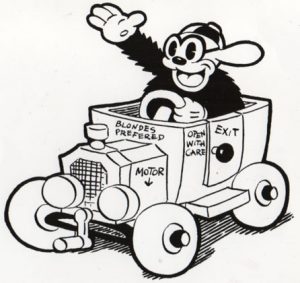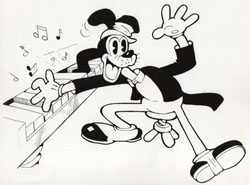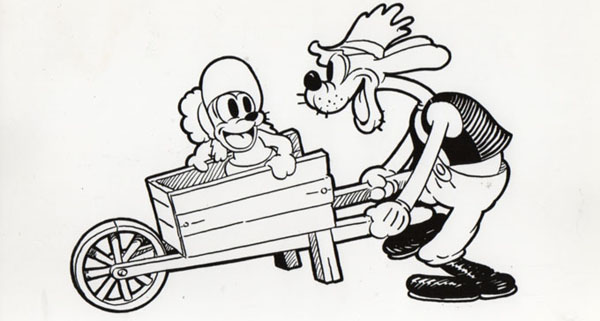In the Summer of 1932, the stock market hit bottom, if you judge by the Dow Jones Industrial Average, which bottomed out at 41.22. The DJIA had lost 89% of its value in less than three years.
At Warner Bros. Cartoons, the Merrie Melodies shorts were carrying their weight. In some cases, they weren’t necessarily plugging the songs that were to be featured.

Pagan Moon (1/13/32). This song was at the top of what popularity it would have when the cartoon was released. The attempt to evoke the languorous mood of a tropical island, with hula girls and fellows fretting their guitars with steel bars, was not especially popular with the audiences (though Betty Boop would attempt to plow the same furrow a few months later). The song was not widely recorded. Victor assigned it to Ted Black’s Orchestra, a Guy Lombardo imitator, with a vocal by Frank Munn.
Here is a British recording from Bob & Alf Pearson, an English musical variety act popular across the big pond.
 Freddy the Freshman (2/20/32), lived on in the memory of Carl Stalling, who later used it in an elephantine rendition in “Bad Ol’ Putty Tat” and as Rhode Island Red’s signature song in Raw Raw Rooster, delivered by Daws Butler in his best Jackie Gleason voice. Victor assigned this to a hot band that played at the Gloria Palast in Manhattan – Gene Kardos and his Orchestra, producing a typically hot rendition with vocal by Dick Robertson. Columbia issued the song on its low-priced Harmony, Velvet Tone, and Clarion labels, as a “five minute” record, playing longer in an attempt to boost sales, in competition with the paper-based “Hit of the Wek” records from Durium, and other long-play records produced by the ARC dime-store labels and by Crown. This version features Dick Robertson (again), and on clarinet Benny Goodman.
Freddy the Freshman (2/20/32), lived on in the memory of Carl Stalling, who later used it in an elephantine rendition in “Bad Ol’ Putty Tat” and as Rhode Island Red’s signature song in Raw Raw Rooster, delivered by Daws Butler in his best Jackie Gleason voice. Victor assigned this to a hot band that played at the Gloria Palast in Manhattan – Gene Kardos and his Orchestra, producing a typically hot rendition with vocal by Dick Robertson. Columbia issued the song on its low-priced Harmony, Velvet Tone, and Clarion labels, as a “five minute” record, playing longer in an attempt to boost sales, in competition with the paper-based “Hit of the Wek” records from Durium, and other long-play records produced by the ARC dime-store labels and by Crown. This version features Dick Robertson (again), and on clarinet Benny Goodman.
This may be the first Warner cartoon to use what would become a standard for Carl Stalling “It Looks Like a Big Night Tonight”, a song recorded several times by Billy Murray. There are also several collegiate fight songs in the soundtrack, including “Fight On” (University of Souther California), “Yale Boola”, and “Rambling Wreck From Georgia Tech”. The cartoon makes use of two of the tropes from collegiate musicals that had been so popular a few years earlier: the big party at which songs are performed, and the big football game. That last trope would be trotted out again in 1934 for the Paramount feature “College Rhythm”, a vehicle for Joe Penner and Lyda Roberti.
Here is the Gene Kardos recording:

Crosby, Columbo, and Vallee (3/19/32), features a bunch of stereotyped American Indians, complaining that paleface crooners are stealing all their squaws. The ARC dime store labels (Perfect, Banner, Oriole, and Romeo) had a full vocal version by Dick Robertson. Brunswick records had Victor Young’s house band record it, with vocal by Fran Frey, singer on many records by George Olsen and his Music.
 Goopy Geer (4/16/32). Warner created a new character for this cartoon, an entertainer-at-the-piano. The song’s verse, however, refers to what the Germans call a “wunderkind” – a child prodigy. American recordings of this song are not thick on the ground. Victor Young’s Orchestra recorded it for Brunswick, with the song’s composer, Herman Hupfeld, doing the singing. A couple of years later, one of Paul Whiteman’s discoveries, Ramona (Davies), recorded it for Victor. Goopy was more popular in England than in this country, with versions by Ambrose and his Orchestra (HMV), Jack Hylton (Decca) featuring Pat O’Malley (later of Disney voice-over fame) on vocal, and Carroll Gibbons on Columbia with a vocal by Al Bowlly. Other songs include Euday Bowman’s “Twelfth Street Rag”, as well as “I Need Lovin’”, a 1926 song that had enjoyed a revival in 1931, with performances by the Rondoliers and their Piano Pals (Columbia, which may include Roy (Mighty Mouse) Halee as top tenor in the quartet), and by Blanche Calloway (Cab Calloway’s older sister) and her Joy Boys on Victor.
Goopy Geer (4/16/32). Warner created a new character for this cartoon, an entertainer-at-the-piano. The song’s verse, however, refers to what the Germans call a “wunderkind” – a child prodigy. American recordings of this song are not thick on the ground. Victor Young’s Orchestra recorded it for Brunswick, with the song’s composer, Herman Hupfeld, doing the singing. A couple of years later, one of Paul Whiteman’s discoveries, Ramona (Davies), recorded it for Victor. Goopy was more popular in England than in this country, with versions by Ambrose and his Orchestra (HMV), Jack Hylton (Decca) featuring Pat O’Malley (later of Disney voice-over fame) on vocal, and Carroll Gibbons on Columbia with a vocal by Al Bowlly. Other songs include Euday Bowman’s “Twelfth Street Rag”, as well as “I Need Lovin’”, a 1926 song that had enjoyed a revival in 1931, with performances by the Rondoliers and their Piano Pals (Columbia, which may include Roy (Mighty Mouse) Halee as top tenor in the quartet), and by Blanche Calloway (Cab Calloway’s older sister) and her Joy Boys on Victor.

It’s Got Me Again (5/16/32). I know of no commercial recordings of this tune, and the straight lyrics from the soundtrack are virtually indecipherable. At one point, we hear a five note musical phrase known to musicians as “You’re a horse’s ass” – in the key of C, that would be G, E, D, C, C. (Those familiar with the “Private Snafu” cartoons will remember this phrase as the opening theme.) Somehow, an old chestnut, “Sailor’s Hornpipe”, also gets in there, as well as the familiar apache dance. The cartoon is standard cat-chases-mice, until the mice gang up on the cat and chase him out. Somehow, it managed to glean an Academy Award nomination, losing out to Disney’s “Flowers and Trees”.

The Queen Was In the Parlor (7/9/32). This was a British song, and I know of no American versions of it. Ambrose recorded it for HMV, with vocal by Sam Browne and the Carlyle Cousins. The song is more or less based on an old nursery rhyme better known to British kids than Americans – “The Queen was in the parlor, eating bread and honey, the King was in the counting house, counting out his money.” The couplet is known in America more as a second verse of “Sing a Song of Sixpence”, though in Britain the rhyme may not be associated with the four-and-twenty blackbirds bit. Goopy Geer makes his second appearance in this film, playing a court jester who winds up fighting the Black Knight.

Moonlight For Two (8/9/32). Again, this song (written by hit-song writer Joseph Burke) was ignored by the record companies, and it is difficult to make out the “straight” lyrics featured early in the cartoon. Goopy Geer cavorts again (in his final appearance) among the hillbillies, assisted by a “red-hot” pot-bellied stove.
Next Time: The Bosko Looney Tunes from the 1931-32 season.


 James Parten has overcome a congenital visual disability to be acknowledged as an expert on the early history of recorded sound. He has a Broadcasting Certificate (Radio Option) from Los Angeles Valley College, class of 1999. He has also been a fan of animated cartoons since childhood.
James Parten has overcome a congenital visual disability to be acknowledged as an expert on the early history of recorded sound. He has a Broadcasting Certificate (Radio Option) from Los Angeles Valley College, class of 1999. He has also been a fan of animated cartoons since childhood.











































Re, “It’s Got Me Again”: I believe that Leon Schlesinger himself was on the committee that picked the cartoons for that year, along with Disney and someone else. Which likely explains how it got the nod. As I recall, Schlesinger boycotted the Oscars for a few years after that, complaining about favoritism in favour of Disney.
Thank you for clearing up a mystery that has been needling me for many years. I had noticed that five-note sol-mi-re-do-do (“You’re a horse’s ass”) motive in the scores of many early cartoons, from every studio and by various composers. I always knew there must be some message there, but I had no idea what it was. I even wrote to Daniel Goldmark about ten years ago asking about it, but he never replied. Finally, an answer! Now that I know, I feel like… well…. (sol-mi-re-do-do)
It doesn’t surprise me that “It’s Got Me Again” got an Oscar nomination. It demonstrates how far the Merrie Melodies had come in just a year; the effect of rain on the rooftop, for example, is really quite striking. But I guess it just couldn’t compete against Technicolor.
I love all these wonderful old songs. Goopy Geer is the greatest! Too bad the stove never got his own series.